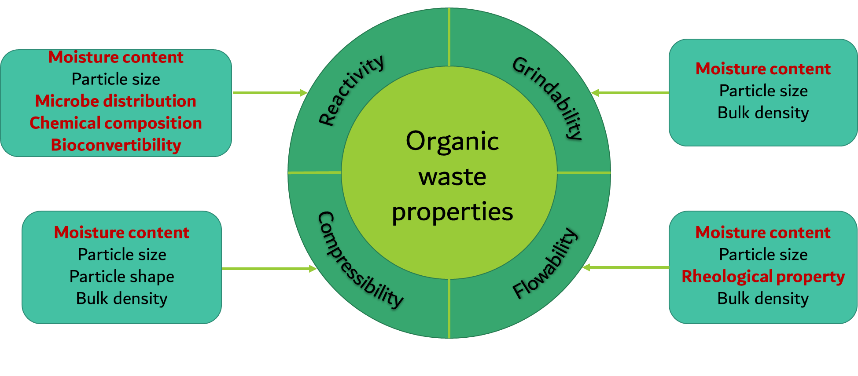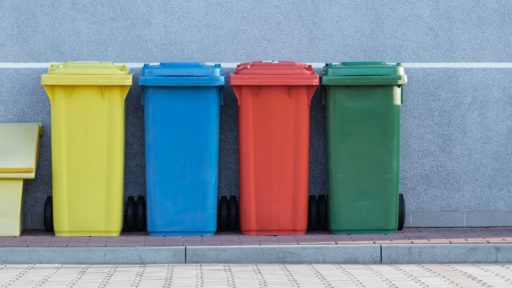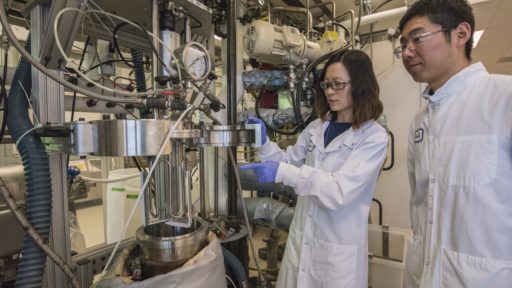Waste-to-Energy
Municipal Solid Waste Characterization and Conversion
We investigate valorization of diverse waste streams to value-added products and develop analytical tools to monitor and understand their attributes that allow for efficient transformations.
In the U.S., organic wastes such as food, paper, yard trimmings, etc. are generated and transported into landfills, amounting to approximately 180 million tons annually. Similarly, the majority of post-consumed plastics, exceeding 80%, accumulate in landfills and the natural environment, causing serious environmental issues.
Our goal is to develop cost-efficient upcycling processes to convert these wastes into valuable chemicals and fuels. We have developed chemical and biological pathways to convert post-consumer absorbent hygiene products, landfill designated organic waste, almond hulls/shells, and municipal solid waste blends into fermentable sugars and biofuels. Our team’s strength lies in the transformation of lab-based technology into pilot-scale processes.

To understand the properties of our waste streams, we develop and adapt a variety of characterization methods. We focus on chemical, physical and biological properties of the feedstock stream, and link critical material properties to their reactivity, flowability, and grindability, as shown in the figure to the right. To ensure product quality, we apply a chain of industrially-compatible unit operations to isolate the product, close the process cycle, and inform the overall process economics.
In the News
Featured Publications
- Liu, S.; Das, L.; Blauch, D. N.; Veronee, C.; Dou, C.; Gladden, J.; Sun, N.; Socha, A. M. “Statistical Design of Experiments for Purification of Vanillin from Commercial Lignin using Ion Exchange” Green Chem., 2020, 22, 3917-3926.
- Ju, Z.; Xiao, W.; Yao, X; Tan, X; Simmons, B. A.; Sale, K. L.; Sun, N. “Theoretical Study on the Microscopic Mechanism of Lignin Solubilization in Keggin-type Polyoxometalate Ionic Liquids” Physical Chemistry Chemical Physics 2020, 22, 2878-2886.
- Yan, J.; Liang, L.; He, Q.; Xu, F.; C. Li, Vi. S. Thompson, E. Goh, M. Konda, H. R. Beller, B. A. Simmons, T. R. Pray, S. Singh and N. Sun. “Conversion of Municipal Solid Waste to Methyl Ketones using an Ionic Liquid-Based Process.” ChemSusChem. 2019, 12, 4313-4322.
- Liang, L.; Yan, J.; He, Q.; Luong, T.; Pray, T. R.; Simmons, B. A.; Sun N. Scale-up of Biomass Conversion using 1-Ethyl-3-methylimidazolium Acetate as the Solvent, Green Energy & Environment 2018, 4, 432-438.
- Liang, L.; Li, C.; He, Q.; Tachea, F.; Tanjore, D.; Luong, T.; Somma, M.; D’Alessio, N.; Pray, T. R.; Sun N. Upgrading of Post-consumer Absorbent Hygiene Products for Bioethanol Production. ACS Sustainable Chem. Eng. 2018, 6, 3589-3595.
- Liang L.; Li C.; Xu F.; He Q.; Yan J.; Luong, T.; Simmons, B. A.; Pray, T. R.; Singh, S.; Thompson, V. S.; Sun, N. Conversion of Cellulose Rich Municipal Solid Waste Blends Using Ionic Liquids: Feedstock Convertibility and Process Scale-up. RSC Advances 2017, 7, 36585-36593.
- Yan, J.; Liang, L.; Pray, T. R.; Sun N.* Impacts, Challenges and Economics of Ionic Liquid Pretreatment of Biomass in Biomass Preprocessing and Pretreatments for Production of Biofuels. Boca Raton: CRC Press. Tumuluru, J. (Ed.) 2018. Chapter 15 401-424.
- Sun, N.; Xu, F.; Sathitsuksanoh; N.; Thompson, V. S.; Cafferty, K.; Li, C.; Tanjore, D.; Narani, A.; Pray, R. T.; Simmons B. A.; Singh S. “Blending Municipal Solid Waste with Corn Stover for Sugar Production Using Ionic Liquid Process” Bioresource Technology, 2015, 186, 200-206.
- Sun, N.; Parthasarathia, R.; Socha, A. M.; Shi, J.; Zhang, S.; Stavila, V.; Sale, K. L.; Simmons B. A.; Singh, S. “Understanding Pretreatment Efficacy of Four Cholinium and Imidazolium Ionic Liquids by Chemistry and Computation”, Green Chem. 2014,16, 2546-2557.
- Sun, N.; Jiang X.; Maxim, L. M.; Rogers, R. D. “Use of polyoxometalate catalysts in ionic liquids to enhance the dissolution and delignification of woody biomass” ChemSusChem, 2011, 4, 65-73.



